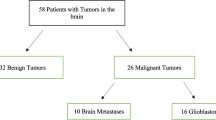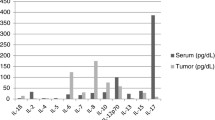Abstract
Depression is found to be associated with up-regulation of inflammatory cytokines. However, the relationship in high grade glioma (HGG) patients is still unclear. In this prospective study, a total 132 HGG patients participated in blood sample collection for inflammatory cytokines detection by ELISA, mental status, quality of life (QOL) and physical functional status testing. The association between inflammatory cytokines and depression risk was assessed using conditional logistic regression. The incidences of depressive symptoms and depression in high grade glioama patients were 45.5 and 25 % respectively during 12 months follow-up. We found the risk of depression was elevated with increased C-reactive protein (CRP) and interleukin-6 (IL-6) in high grade glioma patients after adjustment of confounders. The serum levels of CRP and IL-6 in patients with transient depression and depression were higher than those without depressive symptoms. In addition, depression had significant effects on the survival, QOL and physical functional status of patients. Depression is prevalent among patients with HGG. The present study suggests that serum CRP and IL-6 may serve as a depression marker for HGG patients. The survival and quality of life of HGG patients may be improved by an effective management for depression.



Similar content being viewed by others
Change history
18 August 2017
An erratum to this article has been published.
References
Ostrom QT, Gittleman H, Liao P et al (2014) CBTRUS statistical report: primary brain and central nervous system tumors diagnosed in the United States in 2007–2011. Neuro Oncol 16(Suppl 4):iv1–iv63
Dalton SO, Laursen TM, Ross L et al (2009) Risk for hospitalization with de-pression after a cancer diagnosis: a nationwide, population-based study of cancer patients in Denmark from 1973 to 2003. J Clin Oncol 27(9):1440–1445
Benros ME, Laursen TM, Dalton SO et al (2009) Psychiatric disorder as a first manifestation of cancer: a 10-year population-based study. Int J Cancer 124:2917–2922
Rooney AG, Carson A, Grant R (2011) Depression in cerebral glioma patients: a systematic review of observational studies. J Natl Cancer Inst 103(1):61–76
Schiepers OJ, Wichers MC, Maes M (2005) Cytokines and major depression. Prog Neuropsychopharmacol Biol Psychiatry 29(2):201–217
Litofsky NS, Resnick AG (2009) The relationships between depression and brain tumors. J Neurooncol 94(2):153–161
Satin JR, Linden W, Phillips MJ (2009) Depression as a predictor of disease progression and mortality in cancer patients. A meta-analysis. Cancer 115(22):5349–5361
Capuron L, Gumnick JF, Musselman DL et al (2002) Neurobehavioral effects of interferon-alpha in cancer patients: phenomenology and paroxetine responsiveness of symptom dimensions. Neuropsychopharmacology 26:643–652
Maes M, Meltzer HY, Bosmans E et al (1995) Increased plasma concentrations of interleukin-6, soluble interleukin-6, soluble interleukin-2 and transferring receptor in major depression. J Affect Disord 34:301–309
Howren MB, Lamkin DM, Suls J (2009) Associations of depression with C-reactive protein, IL-1, and IL-6: a meta-analysis. Psychosom Med 71:171–186
Dowlati Y, Herrmann N, Swardfager W et al (2010) A meta-analysis of cytokines in major depression. Biol Psychiatry 67(5):446–457
Jehn CF, Kuehnhardt D, Bartholomae A et al (2006) Biomarkers of depression in cancer patients. Cancer 107:2723–2729
Musselman DL, Miller AH, Porter MR et al (2001) Higher than normal plasma interleukin-6 concentrations in cancer patients with depression: pre- liminary findings. Am J Psychiatry 158:1252–1257
Soygur H, Palaoglu O, Akarsu ES et al (2007) Interleukin-6 levels and HPA axis activation in breast cancer patients with major depressive disorder. Prog Neuropsychopharmacol Biol Psychiatry 31:1242–1247
Bower JE, Ganz PA, Aziz N (2007) Inflammatory responses to psychological stress in fatigued breast cancer survivors: relationship to glucocorticoids. Brain Behav Immun 21:251–258
Miller AH (2009) Mechanisms of cytokine-induced behavioral changes: psychoneuroimmunology at the translational interface. Brain Behav Immun 23(2):149–158
Wu CW, Chen YC, Yu L et al (2007) Treadmill exercise counteracts the suppressive effects of peripheral lipopolysaccharide on hippocampal neurogenesis and learning and memory. J Neurochem 103:2471–2481
Beck AT, Steer RA, Brown GK (1996) Beck Depression Inventory. The Psychological Corporation, San Antonio
Weitzner MA, Meyers CA, Gelke CK et al (1995) The Functional Assessment of Cancer Therapy (FACT) scale. Development of a brain subscale and revalidation of the general version (FACT-G) in patients with primary brain tumors. Cancer 75:1151–1161
Cheng JX, Zhang X, Liu BL (2009) Health-related quality of life in patients with high-grade glioma. Neuro Oncol 11(1):41–50
Giovagnoli A, Tamburini M, Boiardi A (1996) Quality of life in brain tumor patients. J Neurooncol 30:71–80
Bailey RK, Geyen DJ, Scott-Gurnell K et al (2005) Understanding and treating depression among cancer patients. Int J Gynecol Cancer 15:203–208
American Psychiatric Association (1994) Diagnostic and statistical manual of mental disorders: DSM-IV, 4th edn. American Psychiatric Association, Washington, DC
Sellick SM, Crooks DL (1999) Depression and cancer: an appraisal of the literature for prevalence, detection, and practice guideline development for psychological intervention. Psychooncology 8:315–333
Lucas M, Chocano-Bedoya P, Shulze MB et al (2014) Inflammatory dietary pattern and risk of depression among women. Brain Behav Immun 36:46–53
Ader R, Cohen N, Felten D (1995) Psycho-neuro-immunology: interactions between the nervous system and the immune system. Lancet 345:99–103
Yirmiya R (2000) Depression in medical illness: the role of the immune system. West J Med 173(5):333–336
Harbuz MS, Chover-Gonzalez AJ, Jessop DS (2003) Hypothalamo-pituitary-adrenal axis and chronic immune activation. Ann N Y Acad Sci 992:99–106
Raison CL, Borisov AS, Woolwine BJ (2010) Interferon-alpha effects on diurnal hypothalamic-pituitary-adrenal axis activity: relationship with proinflammatory cytokines and behavior. Mol Psychiatry 15(5):535–547
Rich T, Innominato PF, Boerner J et al (2005) Elevated serum cytokines correlated with altered behavior, serum cortisol rhythm, and dampened 24-h rest-activity patterns in patients with metastatic colorectal cancer. Clin Cancer Res 11:1757–1764
Maes M, Bosmans E, Meltzer HY et al (1993) Interleukin-1 beta: a putative mediator of HPA axis hyperactivity in major depression? Am J Psychiatry 150:1189–1193
Vedder H, Schreiber W, Schuld A (2007) Immune-endocrine host response to endotoxin in major depression. J Psychiatr Res 41:280–289
Raison CL, Borisov AS, Majer M (2009) Activation of central nervous system inflammatory pathways by interferon-alpha: relationship to monoamines and depression. Biol Psychiatry 65(04):296–303
Capuron L, Neurauter G, Musselman DL et al (2003) Interferonalpha-induced changes in tryptophan metabolism: relationship to depression and paroxetine treatment. Biol Psychiatry 54:906–914
Kitagami T, Yamada K, Miura H et al (2003) Mechanism of systemically injected interferon-alpha impeding monoamine biosynthesis in rats: role of nitric oxide as a signal crossing the blood-brain barrier. Brain Res 978:104–114
Zhu CB, Blakely RD, Hewlett WA (2006) The proinflammatory cytokines interleukin-1beta and tumor necrosis factor-alpha activate serotonin transporters. Neuropsychopharmacology 31:2121–2131
Bernardino L, Agasse F, Silva B et al (2008) Tumor necrosis factor-alpha modulates survival, proliferation, and neuronal differentiation in neonatal subventricular zone cell cultures. Stem Cells 26:2361–2371
Goshen I, Kreisel T, Ounallah-Saad H et al (2007) A dual role for interleukin-1 in hippocampal-dependent memory processes. Psychoneuroendocrinology 32:1106–1115
Kore RA, Abraham EC (2014) Inflammatory cytokines, interleukin-1 beta and tumor necrosis factor-alpha, upregulated in glioblastoma multiforme, raise the levels of CRYAB in exosomes secreted by U373 glioma cells. Biochem Biophys Res Commun 453(3):326–331
Kumar R, Kamdar D, Madden L et al (2006) Th1/Th2 cytokine imbalance in meningioma, anaplastic astrocytoma and glioblastoma multiforme patients. Oncol Rep 15:1513–1516
Kim JW, Kim YK, Hwang JA et al (2013) Plasma levels of IL-23 and IL-17 before and after antidepressant treatment in patients with major depressive disorder. Psychiatry Investig 10(3):294–299
Mainio A, Hakko H, Niemela A et al (2005) Depression and functional outcome in patients with brain tumors: a population-based 1-year follow-up study. J Neurosurg 103:841–847
Gathinji M, McGirt MJ, Attenello FJ et al (2009) Association of preoperative depression and survival after resection of malignant brain astrocytoma. Surg Neurol 71(3):299–303
Wang Y, Huang M, Jiao JT et al (2014) Relationship between concentrations of IGF-1 and IGFBP-3 and preoperative depression risk, and effect of psychological intervention on outcomes of high-grade glioma patients with preoperative depression in a 2-year prospective study. Med Oncol 31(5):921. doi:10.1007/s12032-014-0921-8
Lucchiari C, Botturi A, Silvani A et al (2015) Cognitive strategies and quality of life of patients with high-grade glioma. Support Care Cancer. doi:10.1007/s00520-015-2691-z
Mackworth N, Fobair P, Prados MD (1992) Quality of life self reports from 200 brain tumor patients: comparisons with Karnofsky performance scores. J Neurooncol 14:243–253
Litofsky NS, Farace E, Anderson F Jr et al (2004) Glioma Outcomes Project Investigators. Depression in patients with high-grade glioma: results of the Glioma Outcomes Project. Neurosurgery 54(2):358–366
Boele FW, Klein M, Reijneveld JC et al (2014) Symptom management and quality of life in glioma patients. CNS Oncol 3(1):37–47
Acknowledgments
This work was supported by grants from the National Natural Science Foundation of China (NSFC. 81272791).
Author information
Authors and Affiliations
Corresponding author
Ethics declarations
Conflict of interest
The author confirms that this article content has no conflict of interest.
Additional information
Jian-tong Jiao, Jun Sun and Jian-fen Ma have contributed to this study equally.
The Editor and Publisher have retracted this article because the authors are unable to provide sufficient documentation of the study, including details of all the patients treated that would substantiate the facts in this paper. The authors disagree with this retraction.
An erratum to this article is available at http://dx.doi.org/10.1007/s11060-017-2592-8.
An erratum to this article is available at https://doi.org/10.1007/s11060-017-2592-8.
Electronic supplementary material
Below is the link to the electronic supplementary material.
About this article
Cite this article
Jiao, Jt., Sun, J., Ma, Jf. et al. RETRACTED ARTICLE: Relationship between inflammatory cytokines and risk of depression, and effect of depression on the prognosis of high grade glioma patients. J Neurooncol 124, 475–484 (2015). https://doi.org/10.1007/s11060-015-1861-7
Received:
Accepted:
Published:
Issue Date:
DOI: https://doi.org/10.1007/s11060-015-1861-7




